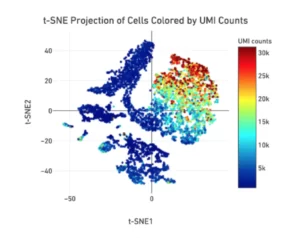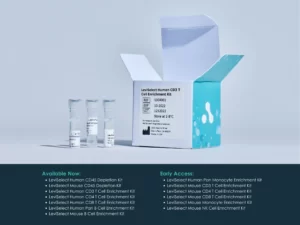The technological advancements that we have witnessed in biotechnology in the last 20 years have been incredible. After sequencing the first few genomes, fast forward to current days and initiatives such as Tabula Sapiens and the Human BioMolecular Atlas Program with goals to atlas all healthy cells in the human body and understand how they interact in the same tissue. It is mind-blowing. In face of such advancement and incredible research, one wonders how all of these technological advancements and knowledge is ready to be applied to improve human health.
This was the exact topic of discussion during the Precision Medicine Leader’s Summit (PMLS) hosted by GenomeWeb September 14-15, 2023 in San Diego. The aim of this inspiring conference was to examine the advances in single cell and spatial biology that will progress the future of precision medicine. There was a combination of exciting insights on how these technologies can be combined to further understand the biology of unique human diseases as well as the realization of the big challenges ahead for wide adoption. Academia, pharma and technology developers were all together and openly sharing the vision and roadblocks. This post summarizes the discussions captured during the meeting and how Levitation Technology is part of the solution – I hope you find it enlightening!
The vision
Beyond the beautiful images that are generated, there is a lot of excitement with spatial analysis. It is clear that identifying the expression and location of expressed RNA and protein in a tissue sample helps characterize and understand some of the mechanisms of disease development. But how can that can be leveraged in practice?
A speaker from Providence Genomics shared the vision for how spatial can be utilized for routine molecular pathology for automated high-throughput marker screening. Artificial Intelligence (AI) tools would cross-check results from spatial analysis with clinical trial databases to inform new possibilities of treatments given the transcriptional and protein profile of the sample – fully automated precision medicine!
Speakers from The Pittsburgh Foundation in Precision Medicine and St Jude Children’s Research Hospital enlightened the audience with use cases of how the combined analysis of single-cell RNA sequencing (scRNA-seq) and spatial data can benefit specific human conditions. In aggressive breast cancer subtypes and some mental disorders, the biomarkers detected with scRNA-seq do not change between affected vs non-affected. However, through spatial analysis it is observed that their location changes, inviting researchers to think about a completely different angle when deciphering disease mechanisms and, therefore, potential new treatments.
Where we stand
Each presenter instilled excitement with a dose of reality. There are many challenges to be overcome to apply these technologies to human health. The list is not that long but the considerable effort will take the engagement of the full scientific community. Given that single-cell analysis adoption penetrates the community’s early majority (34% of market share) and spatial adoption is mostly with innovators (2.5% of market share) the challenges faced are different and thus, split below.
Single-Cell Analysis Challenges
1. Inaccessible samples: relevant tissue samples require processing into single-cell suspensions. Typical methods for sample processing may result in cell stress causing biased cell subtype death and absence from scRNA-seq datasets. This causes a misrepresentation of biology, steering scientists towards incomplete or wrong conclusions. Levitation Technology is uniquely positioned in the market by processing samples for dead cells and debris removal in parallel to cell subtype enrichment with a gentle method that preserves cells’ native state. Review how the LeviCell® systems have allowed research in fragile samples such as brain metastasis and intestinal biopsies in these webinars:
- GenomeWeb – “Elucidating the Leptomeningeal Immune Response to Cancer With Single-Cell Proteogenomic Profiling”
- GEN – “RNA-Seq: Enhancing Single-Cell Data and Cell Recovery Rates for Complex Tissue Samples”
2. Cost of instrumentation and sequencing reagents: the trend highlighted during the conference by the DeciBio team is that technology manufacturers are responding quickly to this need. Box-less or instrument-free options for scRNA-seq library preparation are getting ahead of the curve, delivering to specific needs identified as gaps from the market leader. On the same topic of preserving the full biology of samples, ParseBio showed how their method improved the detection of the number of genes and fragile cell subtypes as compared to 10x Genomics. Singular Genomics also shared that for an equivalent data quality as the market leader Illumina, you can get flexibility in sequencing depth with each run, helping researchers decrease the cost of optimizing new assays.
3. Difficulty in scaling: this is a complex challenge, touching upon different aspects of scaling.
- Lack of standardized and automated sample processing tools is the first workflow bottleneck. LevitasBio® launched the LeviCell EOS system to solve the sample preparation throughput bottleneck. With the same performance as the LeviCell 1.0 system, the LeviCell EOS delivers high sample quality with unbeaten viable cell yield for 4 samples in parallel. This throughput is adequate for scRNA-seq experiments to minimize idle time of the cell suspensions in preparation for analysis. With a run time of 20 minutes, researchers can easily process 3 batches of samples per day to obtain 12 samples scRNA-seq-ready. Read more about the LeviCell EOS performance here.
- Lack of reference datasets to build standardized QC metrics. This was a consensus challenge identified by most speakers during the conference, including technology developers. No current solutions are mentioned.
- Lack of streamlined pipelines for data analysis. Along with the high trend of box-less solutions to enable low to none capital expenditure costs to initiate the single cell journey, another boom observed is in service providers for data analysis as well as the development of user-friendly data analysis tools such as CellxGene, built by the team at the Chan Zuckerberg Initiative.
Spatial Analysis Challenges
- The simple statement that the human brain can’t visually process spatial images with more than 10 markers says it all: AI tools are required to make the most of this deep data.
- Speakers generating spatial data mentioned the high need to allocate budget for investment in servers and digital infrastructure to store and keep data safe.
- Workflow optimization may reach a depth of complexity not fully appreciated. When working with spatial analysis of protein markers, the sequential order at which each antibody is incubated with the tissue slice could affect results.
Interestingly, cost and workflow complexity were not mentioned as challenges for spatial analysis. The excitement of what can be achieved with spatial is taking priority and the challenges appreciated are forward-looking, assuming that the relevance of spatial analysis to human health application is a given. It surely looks that way!
The race between technologies – will there be a winner?
It was clear from the DeciBio’s team that single-cell analysis will continue co-existing with spatial. However, users anticipate allocating up to 60% of their single-cell analysis budget to spatial in the next 5 years.
A speaker from Memorial Sloan Kettering Cancer Center shared his results from a comparison of 5 different methods of sample quality improvement prior to scRNA-seq using fragile samples. Each method has its benefits and disadvantages. The LeviCell EOS system showed a superior ability to preserve the highest percentage of the most fragile cell subtypes in the scRNA-seq dataset from samples derived from mouse cerebrospinal fluid and lymph nodes. Additionally, the speaker reminded us that in the end, the technology applied does not matter as much as answering the scientific questions at hand. It is all about having a varied set of tools in your toolbox!
Check out this webinar with interesting insights about how to best utilize single-cell tools to investigate different biological questions in a webinar produced by LevitasBio in collaboration with Dr Ronan Chaligne, Head of the Single-cell Analytics Innovation Lab (SAIL) at Memorial Sloan Kettering Cancer Center, here.







